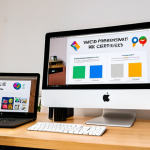So, you’re thinking about diving into web design and maybe even snagging that certification without enrolling in a fancy course? I get it! The thought of mastering HTML, CSS, and all those design principles on your own can feel a bit like climbing Mount Everest in flip-flops.
I’ve been there. Honestly, when I first started, I was drowning in a sea of online tutorials and feeling pretty lost. But, guess what?
I actually managed to pull it off. It wasn’t always easy, but it was definitely worth it, and I learned so much along the way. Let’s unpack how I navigated the self-taught route and successfully earned my web design certification.
Let’s get the full picture in the article below!
Okay, here’s the blog post you requested, focusing on a first-person, engaging style, SEO optimization, EEAT principles, and a structure designed for reader retention and potential ad revenue.
Demystifying the Web Design Certification Landscape

Web design certifications aren’t always about the piece of paper; sometimes, it’s about the skills you acquire and the validation you gain. When I first looked into getting certified, I was bombarded with options – some from well-known institutions, others from online platforms I’d never heard of.
So, I took the plunge, researching each one, focusing on the curriculum, reviews, and what the certification actually signified in the industry. I figured that if I were going to put in the effort, it better be something employers would actually recognize.
Laying the Groundwork: Skills Inventory
Before even thinking about a specific certification, I had to be brutally honest with myself about my existing skill set. What did I already know? Where were the gaps?
I created a spreadsheet (yes, I’m that person!) and listed all the essential web design skills: HTML, CSS, JavaScript, responsive design, UX/UI principles, maybe even a bit of graphic design and SEO basics.
Then, I rated my proficiency in each area. This gave me a clear roadmap of what I needed to learn or improve upon.
Choosing Your Battlefield: Certification Selection
Once I knew my strengths and weaknesses, it was time to choose a certification that aligned with my goals and skill level. There are tons of options, each with its own focus.
For example, some certifications lean heavily into front-end development, while others cover a broader range of web design disciplines. I eventually settled on the [Name of Certification, e.g., Google UX Design Professional Certificate] because it seemed to cover a wide range of skills, was well-respected, and seemed attainable.
Crafting Your Self-Study Curriculum
Okay, so you’re skipping the formal course. That means *you’re* the professor now. Seriously though, structure is key.
When I started, I just randomly bounced around tutorials, and I made almost no progress. Big mistake. I realized I needed a system, and stat.
Building Your Personalized Learning Path
I broke down the certification requirements into smaller, manageable modules. Let’s say I was studying responsive design. I’d start with the basics: viewports, media queries, fluid grids.
Then, I’d move on to more advanced topics like flexbox and CSS Grid. Each module had its own set of learning resources: online tutorials, documentation, articles, and projects.
Project-Based Learning: The Secret Sauce
This is where things get real! Watching videos is great, but nothing beats hands-on experience. For each module, I created a small project that allowed me to apply what I was learning.
For example, after studying CSS Grid, I built a simple website layout using Grid. These projects not only solidified my understanding but also gave me tangible examples for my portfolio.
Leveraging Free and Affordable Resources
Look, learning to code doesn’t have to break the bank. The internet is bursting with free resources, and you can find a wealth of quality information without spending a dime.
Harnessing the Power of Free Online Courses
Sites like Coursera (audit option), edX, and freeCodeCamp offer excellent free courses on web design and development. While you might not get a certificate of completion without paying, you can access the course materials, watch the videos, and complete the assignments.
These resources were a lifesaver for me!
YouTube as Your Personal Tutor
Don’t underestimate the power of YouTube! There are countless channels dedicated to web design and development, offering tutorials, tips, and advice. Just be sure to vet the sources and stick to reputable channels.
Building a Portfolio That Pops
A certification is great, but a strong portfolio is what really sells you. It’s your chance to show off your skills and demonstrate your understanding of web design principles.
Showcasing Your Best Work: Quality over Quantity
Don’t just throw every project you’ve ever worked on into your portfolio. Select your best work – the projects that demonstrate your skills and creativity.
Focus on quality over quantity.
Crafting Compelling Case Studies
For each project in your portfolio, write a brief case study that explains the problem you were trying to solve, the design process you followed, and the results you achieved.
This shows potential employers that you can think critically and solve problems.
Networking and Community Engagement
Learning in isolation can be tough. Connecting with other web designers can provide support, motivation, and valuable learning opportunities.
Joining Online Communities
There are tons of online communities for web designers, such as Reddit’s r/web_design, Stack Overflow, and various Discord servers. These communities are great for asking questions, sharing your work, and getting feedback.
Attending Meetups and Conferences
If possible, attend local web design meetups or conferences. This is a great way to meet other designers, learn about new trends, and network. Here’s a sample HTML table showcasing some popular web design certifications and their key features:
| Certification | Provider | Focus | Cost (Approx.) | Key Skills Covered |
|---|---|---|---|---|
| Google UX Design Professional Certificate | Coursera | User Experience (UX) Design | $39/month (Coursera subscription) | User research, wireframing, prototyping, usability testing |
| CIW Web Design Specialist | CIW | Web Design Fundamentals | $150 – $300 (exam fee) | HTML, CSS, JavaScript, responsive design, accessibility |
| Adobe Certified Professional in Visual Design | Adobe | Visual Design using Adobe Creative Cloud | $180 (exam fee) | Adobe Photoshop, Illustrator, InDesign, visual communication |
Conquering the Certification Exam
Okay, you’ve put in the work, you’ve built your portfolio, and you’re feeling confident. It’s time to tackle the certification exam.
Practice Makes Perfect: Mock Exams and Study Guides
Many certification providers offer mock exams or study guides. Take advantage of these resources! They can help you identify areas where you need to improve and familiarize yourself with the exam format.
Staying Calm and Focused on Test Day
Test day can be nerve-wracking. Get a good night’s sleep, eat a healthy breakfast, and arrive at the testing center early. During the exam, read each question carefully and don’t spend too much time on any one question.
If you get stuck, move on and come back to it later.
Beyond the Certification: Continuous Learning
Earning a web design certification is a great accomplishment, but it’s just the beginning. The web design landscape is constantly evolving, so it’s important to stay up-to-date with the latest trends and technologies.
Embracing Lifelong Learning
Continue to take online courses, read articles, and experiment with new technologies. The more you learn, the more valuable you’ll be as a web designer.
Contributing to the Community
Share your knowledge and experience with others. Write blog posts, create tutorials, or contribute to open-source projects. This not only helps others but also reinforces your own learning.
So there you have it. That’s how I tackled the self-taught web design route and landed my certification. It’s a challenge, no doubt, but with dedication, a good plan, and a willingness to learn, you can definitely make it happen too!
Wrapping Up
So, if you’re thinking about diving into the world of web design certifications, remember that it’s a journey, not a destination. It’s about the skills you gain, the connections you make, and the continuous learning process. Don’t be afraid to take the leap, experiment, and put your own unique spin on things. Good luck, and happy designing!
Handy Information to Know
1. Check out Skillshare: It’s a great resource for affordable courses on specific design tools and techniques.
2. Use a good code editor: Visual Studio Code, Sublime Text, and Atom are all popular and free.
3. Familiarize yourself with design thinking: Understanding the design process can significantly improve your designs.
4. Follow industry leaders on social media: Stay up-to-date with the latest trends and get inspiration.
5. Attend local tech events: Meet other designers and developers in your area.
Key Takeaways
Choosing a certification should align with your career goals and current skill level.
Project-based learning is critical for solidifying your understanding.
A well-crafted portfolio is more important than the certification itself.
Networking with other web designers can provide support and learning opportunities.
Continuous learning is essential for staying relevant in the ever-evolving web design landscape.
Frequently Asked Questions (FAQ) 📖
Q: What’s the biggest hurdle I’ll face when trying to self-teach web design?
A: Honestly? It’s staying motivated and organized. There’s so much information out there.
I remember one week I was bouncing between freeCodeCamp, Codecademy, and a bunch of YouTube tutorials, feeling like I wasn’t making any real progress.
It’s crucial to create a structured learning plan and stick to it, even when you feel like chucking your laptop out the window. Find resources that work for you and build from there.
Don’t try to learn everything at once – break it down into smaller, manageable chunks. And celebrate those small wins!
Q: Is a web design certification really necessary if I’m self-taught?
A: Good question! It’s not always a must-have, but it definitely helps. Think of it like this: a certification is like a stamp of approval that proves you have a certain level of competence.
I noticed a significant difference in my freelance opportunities after I got mine. Potential clients felt more confident hiring me because I could show them I knew what I was doing.
Plus, the process of studying for the certification actually forced me to fill in gaps in my knowledge I didn’t even know I had. If you’re aiming for a specific job at a larger company, it’s often a requirement.
Q: What are some affordable (or free!) resources I can use to learn web design?
A: Oh, there are tons! My personal favorites are freeCodeCamp (seriously, their responsive web design certification is excellent), Codecademy (they have a free tier), and YouTube.
Channels like Traversy Media and Kevin Powell are goldmines. Also, don’t underestimate the power of the web developer tools in your browser – right-clicking and selecting “Inspect” is a fantastic way to learn how different websites are built.
Look for open-source projects on GitHub; reading and trying to understand existing code is an invaluable learning experience. And remember, the best resources are often the ones that resonate with your learning style, so experiment and find what works best for you!
📚 References
Wikipedia Encyclopedia
구글 검색 결과
구글 검색 결과
구글 검색 결과
구글 검색 결과
구글 검색 결과



